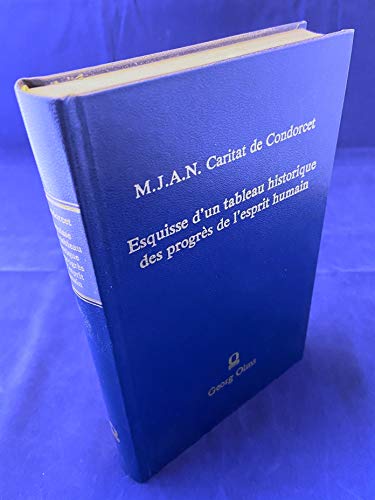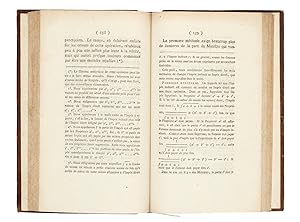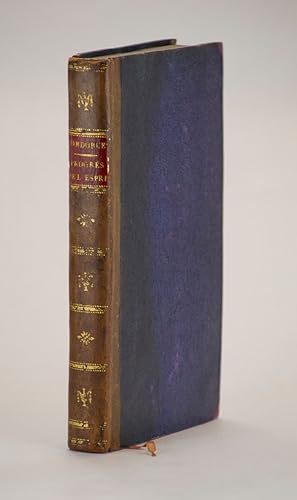condorcet marie jean antoine nicolas caritat marquis (16 Ergebnisse)
Produktart
- Alle Product Types
- Bücher (16)
- Magazine & Zeitschriften
- Comics
- Noten
- Kunst, Grafik & Poster
- Fotografien
- Karten
- Manuskripte & Papierantiquitäten
Zustand
Einband
Weitere Eigenschaften
- Erstausgabe (8)
- Signiert (1)
- Schutzumschlag
- Angebotsfoto (10)
Gratisversand
- Versand nach USA gratis
Land des Verkäufers
Verkäuferbewertung
-
Beschouwingen over de negerslavernij [Réflexions sur l'esclavage des nègres].
Verlag: Heureka, 1991
ISBN 10: 9062622828ISBN 13: 9789062622825
Anbieter: Kloof Booksellers & Scientia Verlag, Amsterdam, Niederlande
Buch
Zustand: as new. Weesp: Heureka,1989. Paperback. 83 pp. Nederlandse vertaling van : Réflexions sur l'esclavage des nègres. - 1788 - De markies de Condorcet (1743-1794), was een van de laatste denkers van de Verlichting. Hij leefde lang genoeg om de ontaarding van de Verlichtingsidealen mee te maken tijdens de Franse Revolutie. Hij pleegde zelfmoord op de vlucht voor het Schrikbewind van Robespierre. Condorcets nog vóór de Revolutie geschreven korte verhandeling tegen de slavernij in de koloniën (1781), is een vlammend humanistisch betoog. Veel zinsneden zijn nog steeds actueel: 'Een maatschappij waar handhaving van de orde noopt tot het schenden van de rechten van burgers of van vreemdelingen, is geen samenleving van mensen maar van een bende schurken.' Condition : as new copy. ISBN 9789062622825. Keywords : HISTORY, slavery.
-
Esquisse d'un tableau historique des progrès de l'esprit humain.
Anbieter: Kloof Booksellers & Scientia Verlag, Amsterdam, Niederlande
Zustand: very good. Texte revu et présenté par O.H. Prior. Nouvelle édition par Yvon Belaval. Paris : J. Vrin, 1970. Paperback. xxxviii,245,[1] pp. First published in 1795. Condition : very good copy. Keywords : PHILOSOPHY,
-
Esquisse d'un tableau historique des progrès de l'esprit humain.
Verlag: Georg Olms Verlag, 2001
ISBN 10: 3487070413ISBN 13: 9783487070414
Anbieter: Kloof Booksellers & Scientia Verlag, Amsterdam, Niederlande
Buch
Zustand: as new. Hildesheim : Georg Olms, 1981. Hardbound. Reprint of 1795-edition. viii,364 pp. Condition : as new copy. ISBN 9783487070414. Keywords : PHILOSOPHY,
-
Voltaires Levnet, tilligemed hans Domme over Religion og Bibel. Oversat ved O. Horrebow.
Anbieter: Herman H. J. Lynge & Søn ILAB-ABF, Copenhagen, Dänemark
Verbandsmitglied: ILAB
Kiøbenhavn: A. Soldin, 1802. 8vo. Indbundet i et samtidigt hldrbd. med rygforgyldning. Titeletiket i skind med forgyldt titel. Kantslid. Øvre kapitæl slidt. Hjørner stødte. Et brændemærke på forpermermen har afgivet en brunplet på de første 6 blade. Enkelte brunpletter, ellers ren og pæn. Trykt på godt papir. Ex libris Nicolai Bøgh. Titeloplag, idet indholdet er identisk med førstetrykket fra 1798.
-
Vie de Monsieur Turgot.
Verlag: 'Londres', [i.e. Paris?, n.p.], 1786., 1786
Anbieter: Bernard Quaritch Ltd ABA ILAB, London, Vereinigtes Königreich
Erstausgabe
8vo, pp. [iv], 299, [1, errata]; small loss to lower corner of T1, small hole to margin of last leaf, very occasional light foxing, light soiling to final page, otherwise a very good, crisp copy in 19th-century sprinkled calf, spine gilt in compartments, gilt lettering-piece; joints split but holding, extremities slightly worn, rear inner hinge split.First edition of the sole example of Condorcet's economic writings to employ mathematics. Condorcet's use of 'the sign ? as a sign of summation of finite quantities' is an 'innovation' in his ten-page footnoted discussion of the various ways 'in which indirect taxation could be replaced by direct taxation and the effects of such a change' (Theocharis, p. 65). This biography, together with that of Dupont, is the chief contemporary account of the renowned financial reformer and physiocratic sympathizer, Turgot.Condorcet's 'mathematical treatment of probabilities, and his discussion of differential equations and finite differences, show an ability which might have put him in the first rank had he concentrated his attention on mathematics' (Ball, A Short Account of the History of Mathematics, p. 388).The work was much called for; four editions were published in 1786. This is the earliest, with a misprint in the errata: page 134 instead of 104 (identified as edition 'A' in Anton Gerits' 'Condorcet's Vie de Monsieur Turgot', Harvard Library Bulletin NS Winter 1992-1993, vol. 3, no. 4, p. 35).Einaudi 1217; Fisher, p. 174; Goldsmiths' 13128; INED 1186 (a later 1786 edition); Jevons, p. 278; Kress B.1032; Mattioli 746; see Theocharis, p. 65. Language: French.
-
Esquisse d'un Tableau Historique des Progrès de L'Esprit Humain. Ouvrage posthume de Condorcet
Erscheinungsdatum: 1795
Anbieter: Attic Books (ABAC, ILAB), London, ON, Kanada
Card covers. Zustand: Good. [2], 364 p. 20 cm. Bound in cardboard with blue tape spine. Handwritten spine label. Dampstained upper corners for approximately first 200 pages. Small ink marks pp. 214-218. Light foxing. Scarce edition probably pirated after the original from the same year. This history of the progress of mankind is one of the main works of the Enlightenment as well of historical thought in general. Published after Condorcet's death, this book traces human history through various eras from savagery to the revolution of his own lifetime. His prophetic view of the tenth epoch forecasts the destruction of inequality between nations and classes. French text.
-
Mémoires de Condorcet sur la Révolution Française. Extraits de Sa Correspondance et de Celles de Ses Amis.
Anbieter: Librairie Laurencier, Bordeaux, AQUIT, Frankreich
Verbandsmitglied: ILAB
Paris,Ponthieu en 1824.2 vols.in-8 en demi-reliure de l'époque.362 et 390 pages avec les Tables des Matières.Mémoires apocryphes tirés de la correspondance de Condorcet avec Suard,Morellet,Rousseau,D'Alembert,Diderot etc.Bon état avec qques rousseurs.
-
Entwurf eines historischen Gemähldes der Fortschritte des menschlichen Geistes
Verlag: J. G. Cottasche Buchhandlung, Tübingen, 1796
Anbieter: Versandantiquariat Cornelius Lange, Würzburg, Deutschland
Buch Erstausgabe
Hardcover. Zustand: Befriedigend. 1. Auflage. 4 ungez. Bl.; 326 S.; 1 ungez. Bl. 8°. Modernes Halbleder auf drei Falschen Bünden mit Deckelbezügen in Marmorpapier. Rückenschildchen in Leinen. Alte fliegende Vorsätze eingebunden. Ehemaliges Bibliotheksexemplar (Mercantile Library, New York). Einband minimal berieben. Vorsätze leicht gebräunt und fleckig. Titelblatt knittrig sowie mit Bibliotheksstempel. Seiten unregelmäßig beschnitten, mit Rand- und Eckläsuren, altersgemäß gebräunt und gelegentlich leicht fleckig. S. 69/70 mit (anscheinend herstellungsbedingter) Fehlstelle im weißen Rand. S. 121 und 211 mit Bibliotheksstempel. Vereinzelt mit sauberen Anstreichungen. Altes vorderes fliegendes Vorsatz recto mit Eintragungen in Tinte und Bibliotheksstempel. Altes hinteres fliegendes Vorsatz verso ebenfalls mit Bibliotheksstempel. Deutsche Erstausgabe. Fromm 5669.
-
Esquisse d'un tableau historique des progrès de l'esprit humain ouvrage posthume de Condorcet
Verlag: [S.l.], 1795
Anbieter: ANTIQUARIAT.WIEN Fine Books & Prints, Wien, Österreich
Halblederband der Zeit, 8°, 2 Blatt, 364 Seiten; mit alten handschritlichen Vermerken auf der Titelei. Zu Berginn etwas fleckig fr 320 Buch.
-
Vie De M. Turgot.
Verlag: London [ie. Paris]: 1786., 1786
Anbieter: D & E LAKE LTD. (ABAC/ILAB), Toronto, ON, Kanada
8vo. pp. 3 p.l., 246. old half calf, rebacked. One of several issues with identical imprint, this one being Gerits' issue 'B'. The present work and Dupont de Nemours' earlier memoir (1782) are the two major contemporary biographies of the great French statesman, economist, and financial reformer. The Life is also important for containing an early contribution to mathematical economics, in a passage where Condorcet discusses the various mathematical ways "in which indirect taxation could be replaced by direct taxation and the effects of such a change". (Theocharis, Early Development in Maathematical Economics, p. 65) A.Gerits in Harvard Library Bulletin, 1992-93, Vol. III, No. 4. cfCioranescu 20417. cfEinaudi 1217. cfGoldsmiths' 13128. cfKress B.1031-33. Palgrave III p. 594.
-
Esquisse d'un tableau historique des progrès de l'esprit humain. Ouvrage posthume de Condorcet.
Verlag: Chez Agasse, Paris, 1795
Anbieter: Heritage Book Shop, ABAA, Beverly Hills, CA, USA
Erstausgabe
"Can Man Become Perfect?" CONDORCET, [Marie Jean Antoine Nicolas Caritat, Marquis de]. Esquisse d'un tableau historique des progrès de l'esprit humain. Ouvrage posthume de Condorcet. Paris: Chez Agasse, L'an III. de la République [1795]. First edition of Condorcet's philosophical masterpiece. Octavo (7 7/8 x 4 13/16 inches; 201 x 123 mm). viii, 389, [1, blank] pp. Contemporary quarter calf over dark blue paste-paper boards, spine gilt with dotted bands and ornaments, gilt red morocco lettering piece. Old owner's signature on half-title. A quarter-inch marginal tear at the bottom of leaf M42 that does not affect the text. Light foxing throughout. A blue ink stain on top edge from signature Z to the end. Overall, a clean and attractive copy. "It was the gospel of the nineteenth century that mankind is destined for indefinite future progress. Condorcet [1743-1794], looking back and then forward, saw proof of this in the growing equality between classes and nations, the intellectual, physical and moral improvement of man; and he prophesied that popular education on correct principles would strengthen and assure this progress.In the Esquisse [âAn Historical Outline of the Progress of the Human Mind'], published after his death, Condorcet traces the history of man through epochs, the first three covering his progress from savagery to pastoral community and thence to the agricultural state. The next five span the growth of civilizations and knowledge down to Descartes, and the ninth describes the revolution of Condorcet's own lifetime, from Newton to Rousseau. The prophetic view of the tenth epoch shows Condorcet at his most original. He forecasts the destruction of inequality between nations and classes, and the improvement, intellectual, moral and physical of human nature.it is as the most fully developed exposition of the progress of man that Condorcet's work is now remembered, and it is this which has given its lasting appeal" (Printing and the Mind of Man). Printing and the Mind of Man 246. HBS 65358. $2,000.
-
Esquisse d'un tableau historique des progrès de l'esprit humain. - [PMM 246 - CAN MAN BECOME PERFECT?]
Anbieter: Herman H. J. Lynge & Søn ILAB-ABF, Copenhagen, Dänemark
Verbandsmitglied: ILAB
Erstausgabe
Paris, Agasse, l'an III de la République, une et indivisible (1795). 8vo. Bound in a very nice newer pastiche-binding in full mottled calf. Five raised bands and gilt title-label to spine. A very nice, clean, fresh, and attractive copy. VIII, 389 pp. The rare first edition of Condorcet's main work, "the most fully developed exposition of the progress of man" (Printing and the Mind of Man, p. 149) and a main work of the Enlightenment as well as of historical thought in general. The author was the creator of what came to found the basis for the modern French system. The great French philosopher, political thinker and mathematician, M.J.A. Condorcet (1743 - 1794), played a seminal role in 18th century France. He was friends with the likes of d'Alembert, Voltaire, Turgot etc., and he greatly contributed to the social and political debates of politically turbulent France. As one of the few, he advocated a liberal economy, equality in public education as well as in gender and race etc. He preached constitutionalism, and his thoughts that are still influential today embody those of the Enlightenment and rationalism."A belief in the ultimate perfectibility of man lies at the root of all progressive thinking about the human condition. The "philosophes" and Godwin had familiarized the reading public with this notion" it was left to Condorcet to give it its finest and most durable expression. It was the gospel of nineteenth century that mankind is destined for indefinite future progress. Condorcet, looking back and then forward, saw proof of this in the growing equality between classes and nations, the intellectual, physical and moral improvement of man" and he prophesied that popular education on correct principles would strengthen and assure this progress." (PMM 246).During the French Revolution Condorcet came to play a dominating role, advocating a rationalist reconstruction of society, and he championed many liberal causes. In 1791 he became secretary of the Legislation Assembly, and the institution adopted his scheme for comprehensive state education, which later became the basis of the modern French system. In the struggle between the two political parties, the Girondists and the Montagnards, Condorcet occupied an independent role, but when he opposed the death penalty under the trial of King Louis XVI (still supporting the actual trial), and the radical Montagnards gained more power, Condorcet was branded a traitor, and in October 1793 a warrant was issued for his arrest. He now went into hiding for several months (almost a year), and it is during these months that he writes the work that was to become his most important, the main work "Esquisse." ("Sketch for a Historical Picture of the Progress of the Human Mind"), which was published posthumously, the year after his death. In 1794 Condorcet was arrested, and two days later he was found dead in his cell, -it is unknown whether he committed suicide or was murdered because of fear of fierce reactions that would definitely have occurred had the beloved man been officially sentenced to the death penalty."In the Esquisse", published after his death, Condorcet traces the history of man through epochs, the first three covering his progress from savagery to pastoral community and thence to the agricultural state. The next five span the growth of civilizations and knowledge down to Descartes, and the ninth describes the revolution of Condorcet's own lifetime, from Newton to Rousseau. The prophetic view of the tenth epoch shows Condorcet at his most original. He forecasts the destruction of inequality between nation and classes, and the improvement, intellectual, moral and physical, of human nature., it exercised considerable influence on Comte. But it is as the most fully developed exposition of the progress of man that Condorcet's work is now remembered, and it is this which has given it its lasting appeal." (PMM 246).
-
Compendio de la obra inglesa intitulada Riqueza de las naciones. Hecho por el Marques de Condorcet, y traducido al castellano con varias adicciones des original, por Don Cárlos Martinez de Iurjo, Oficial de la primera Secretaría de Estado.
Verlag: Madrid: en la Imprenta Real, 1792, 1792
Anbieter: Peter Harrington. ABA/ ILAB., London, Vereinigtes Königreich
Erstausgabe
First Spanish translation of Condorcet's summary of Smith's Wealth of Nations, the first appearance of any of his work in Spanish prior to the complete translation by J. A. Ortiz in 1794. The translator of the present summary is the young marqués de Casa, Carlos Martinez de Yrujo y Tacón (1763-1824). "This is a translation of the Roucher/Blavet condensation of Wealth of Nations in the Bibliothèque de l'homme publique. to which Condorcet lent his name. The translator restores to the text a summary of Smith's Digression on the Bank of Amsterdam (WN IV iii. b 479-88) + a five-line qualification of the argument for free trade. The criticism of Catholic clergy is omitted." (Tribe). Palau 59126; Tribe 47. This edition not listed in Goldsmiths', Kress, or Vanderblue. Octavo (174 x 108 mm). Contemporary tree sheep, flat spine ruled and decorated in gilt, red morocco label, marbled endpapers, red edges. 19th-century ownership inscription to front free blank leaf, extremities lightly rubbed, one corner slightly worn; a crisp, clean copy in fine condition.
-
Essai sur l'application de l'analyse à la probabilité des décisions rendues à la pluralité des voix.
Verlag: De k'Imprimerie Royale, Paris, 1785
Anbieter: Heritage Book Shop, ABAA, Beverly Hills, CA, USA
Erstausgabe
"The First Large-Scale Attempt to Apply Mathematics to Knowledge of Human Phenomena" CONDORCET, [Marie Jean Antoine Nicolas Caritat], Marquis de. Essai sur l'application de l'analyse à la probabilité des décisions rendues à la pluralité des voix. Paris: De l'Imprimerie Royale, 1785. First edition.Quarto. [2], cxci, [1, blank], 304 pp. Decorative woodcut head- and tail-pieces. Contemporary French mottled calf, spine decorated in gilt with five raised bands. Marbled endpapers, all edges red. First and last few pages browned at edges, . gathering K is browned a Q and 2G is toned. Otherwise, very good and very scarce. "Condorcet's most significant and fruitful endeavor was in a field entirely new at the time. The subject was one that departed from the natural sciences and mathematics but nevertheless showed the way toward a scientific comprehension of human phenomena, taking the empirical approach of natural science as its inspiration and employing mathematics as its tool. Condorcet called this new science âsocial mathematics.' It was apparently intended to comprise.a statistical description of society, a theory of political economy inspired by the Physiocrats, and a combinatorial theory of intellectual processes. The great work on the voting process, published in 1785, is related to the latter. Condorcet there sought to construct a scheme for an electoral body the purpose of which would be to determine the truth about a given subject by the process of voting and in which each elector would have the same chance of voicing the truth.No doubt the results obtained in the Essai d'application de l'analyse were modest ones. âIn almost all cases,' Condorcet said, âthe results are in conformity with what simple reason would have dictated; but it is so easy to obscure reason by sophistry and vain subtleties that I should feel rewarded if I had only founded a single useful truth on a mathematical demonstration' (Essai, p. ii). One must nevertheless recognize, in this work.the first large-scale attempt to apply mathematics to knowledge of human phenomena" (D.S.B.). Brunet VI, col. 472. HBS 66958. $7,500.
-
ENCYCLOPÉDIE, OU DICTIONNAIRE RAISONNÉ DES SCIENCES, DES ART ET DES MÉTIERS, PAR UNE SOCIÉTÉ DE GENS DE LETTRES. [28 Volumes, Complete]
Verlag: Briasson, David, Le Breton, Durand; Samuel Faulche & Compagnie 1751 - 1772, Paris; Neufchastel [Neuchatel], 1751
Anbieter: Second Story Books, ABAA, Rockville, MD, USA
Erstausgabe
Hardcover. First Edition. A complete 28-volume set of the true first edition of Denis Diderot and Jean le Rond d'Alembert's Encyclopedie, comprised of 17 volumes of text and 11 volumes of plates. The text volumes were published between 1751 and 1765, the first seven listing Paris as their place of publication, and the remaining 10 volumes (all released in 1765) stating "Neufchastel". The titlepages of the text volumes include accent marks. These accord with the standard points for a true first edition. All 2,885 of the original plates appear to be present. Some bibliographies count the double-, triple-, etc. plates as multiples (rendering a count of 3,129 plates). The figure "2,885" reflects the numbering of the encyclopedists themselves and represents the total of originally included plates (See Darnton, The Business of Enlightenment). All text volumes are double-columned. All 28 volumes are bound in contemporary tree-calf, with banded and gilt-ornamented spines, and brown leather spine labels with gilt lettering. The textblock edges of all volumes are dyed red. All volumes have marbled endpapers, and (unless otherwise indicated) cloth bookmarks. Shelved in Room C. Sold as is. Text / Article Volumes ENCYCLOPEDIE, OU DICTIONNAIRE RAISONNE DES SCIENCES, DES ARTS ET DES METIERS, PAR UNE SOCIETE DE GENS DE LETTRES. TOME PREMIER; Diderot, Denis; d'Alembert, Jean le Rond; Briasson, David, Le Breton, Durand : Paris, 1751; First Edition. Folio, [xii], [fold-out chart], lii, 914 pages, [errata page]. In good plus condition. Boards show light wear to edges, light plus bumping and wear to corners, and significant cracking to leather along joints. Textblock has light shelf wear and several instances of light soiling to edges, very minor age-toning to pages throughout interiorly, and some light foxing to first few leaves. The fold-out chart Systeme Figure des Connaissances Humaines is intact, but has a 1.5-inch tear along the bottom fold. Includes the famous frontispiece engraving by Cochin, with explanatory text, as well as d'Alembert's Discours Preliminaire. ALS of noted Diderot scholar Norman Torrey to Columbia President William Russell, dated November 11, 1953, laid in at front. Torrey explains to Russell how to determine if his copy of the Encyclopedie is a genuine first edition. ENCYCLOPEDIE, OU DICTIONNAIRE RAISONNE DES SCIENCES, DES ARTS ET DES METIERS, PAR UNE SOCIETE DE GENS DE LETTRES. TOME SECOND; Diderot, Denis; d'Alembert, Jean le Rond; Briasson, David, Le Breton, Durand : Paris, 1751; First Edition. Folio, [iv], iv, 871 pages, [one errata page]. In good condition. Boards show light wear to edges, moderate bumping and wear to corners, , some minor chipping to leather on covers and at head of spine, and significant cracking to leather along joints. Textblock has several instances of light soiling to edges, very minor age-toning to pages throughout interiorly, and some light foxing to first few leaves. ENCYCLOPEDIE, OU DICTIONNAIRE RAISONNE DES SCIENCES, DES ARTS ET DES METIERS, PAR UNE SOCIETE DE GENS DE LETTRES. TOME TROISIEME; Diderot, Denis; d'Alembert, Jean le Rond; Briasson, David, Le Breton, Durand : Paris, 1753; First Edition. Folio, [iv], xvi, 905 pages, [one errata page]. In good plus condition. Boards show light wear to edges, light plus bumping and wear to corners, and significant cracking to leather along joints. Textblock has light shelf wear to bottom edge, several instances of light soiling to top edge, very minor age-toning to pages throughout interiorly, and some light foxing to first few leaves. ENCYCLOPEDIE, OU DICTIONNAIRE RAISONNE DES SCIENCES, DES ARTS ET DES METIERS, PAR UNE SOCIETE DE GENS DE LETTRES. TOME QUATRIEME; Diderot, Denis; d'Alembert, Jean le Rond; Briasson, David, Le Breton, Durand : Paris, 1754; First Edition. Folio, [iv], iv, 1098 pages. In good plus condition. Boards show light wear overall, light plus bumping and wear to top corners, and moderate cracking to leather along joints. Textblock has light shelf wear to bottom edge, several instances of light soiling to top edge, very minor age-toning to pages throughout interiorly, and some light foxing to first few leaves. ENCYCLOPEDIE, OU DICTIONNAIRE RAISONNE DES SCIENCES, DES ARTS ET DES METIERS, PAR UNE SOCIETE DE GENS DE LETTRES. TOME CINQUIEME; Diderot, Denis; d'Alembert, Jean le Rond; Briasson, David, Le Breton, Durand : Paris, 1755; First Edition. Folio, [iv], xviii, 1011 pages, [one errata page]. In good condition. Boards show light wear overall, moderate bumping and wear corners, and moderate plus cracking to leather along joints. Textblock has several instances of light soiling, very minor age-toning to pages throughout interiorly, and some light foxing to first few leaves. ENCYCLOPEDIE, OU DICTIONNAIRE RAISONNE DES SCIENCES, DES ARTS ET DES METIERS, PAR UNE SOCIETE DE GENS DE LETTRES. TOME SIXIEME; Diderot, Denis; d'Alembert, Jean le Rond; Briasson, David, Le Breton, Durand : Paris, 1756; First Edition. Folio, [iv], viii, 926 pages, [two errata pages]. In good condition. Boards show moderate wear to edges, light bumping and wear to corners, and moderate plus cracking to leather along joints. Textblock has light shelf wear to bottom edge, several instances of light soiling, very minor age-toning to pages throughout interiorly, and some minor creasing to top fore-edge of blank leaves / endpapers at back of volume. ENCYCLOPEDIE, OU DICTIONNAIRE RAISONNE DES SCIENCES, DES ARTS ET DES METIERS, PAR UNE SOCIETE DE GENS DE LETTRES. TOME SEPTIEME; Diderot, Denis; d'Alembert, Jean le Rond; Briasson, David, Le Breton, Durand : Paris, 1757; First Edition. Folio, [iv], xiv, 1030 pages. In good plus condition. Boards show light wear overall, light bumping to corners, and minor cracking to leather along joints. Textblock has light shelf wear to bottom edge and very minor age-toning to pages throughout interiorly. ENCYCLOPEDIE, OU DICTIONNAIRE RAISONNE DES SCIENCES, DES ARTS ET DES METIERS, PAR UNE SOCIETE DE GENS DE LETTRES. TOME H.
-
THE RUSSELL COLLECTION: BOOKS, BROADSIDES, AND EPHEMERA OF THE FRENCH REVOLUTION
Verlag: 1571 - 1947, 1571
Anbieter: Second Story Books, ABAA, Rockville, MD, USA
Erstausgabe Signiert
The Russell Collection contains over 300 books, broadsides, and pieces of ephemera produced between the waning decades of the ancien regime and the fall of Napoleon Bonaparte. The collection was assembled in the early 1950s by William F. Russell (1890 - 1956), President of Columbia University's Teacher's College from 1949 to 1954. With material spanning the 16th to the early 20th century, the majority of the collection was produced between 1775 and 1800. Highlights include early editions of the 1791 and 1793 French Constitutions, letters written and signed by pioneering economist Anne Robert Jacques Turgot, and official documents signed by Robespierre and other members of the Comite du Salut Public. The Collection is comprised of the following components: 1) The French Monarchy and the Ancien Regime; 2) Ideological Roots of Revolution; 3) The Transition to Republicanism and Collapse of the Monarchy; 4) The National Convention and the Committee for Public Safety; 5) Historical and Contemporary Context; and, 6) Miscellanea (Ephemera, Manuscripts, and Books). Most of the printed material was published by one of the two major publishing houses in Limoges. This concentration of material from a single city offers perspective on the publication and distribution of political and governmental texts in a particular city or departement (one which was especially impacted by the Crown's frequently shifting tax and trade policies). It also provides important insight into the early work and career of Anne Robert Jacques Turgot, who served as intendant of Limoges from 1761 - 1774. Limoges was home to several printing houses which, at various times during the Monarchy and Revolution, were designated as official printers of government documents for the region. Most notable among these were the Barbou and Dalesmes families. Both families had been established printers for centuries, but the Barbou appear to have been too closely aligned with the ecclesiastical hierarchy - after 1791, all of the officially published material printed in Limoges was released by members of chez Dalesme. 1) The French Monarchy and the Ancien Regime A significant portion of the collection is made up of documents from the reign of Louis XVI, issued by the crown, members of the regime, and the Parisian Parlement in the two decades leading up to the Revolution. These items, ranging from royal decrees to trial testimonies, illustrate governmental practice under the monarchy, especially as it relates to trade policy and criminal justice. 2) Ideological Roots of Revolution The Russell Collection includes a number of books and tracts from writers crucial to the development of revolutionary thought and discourse in France during the 18th-century. First or early editions by Mirabeau, Raynal, Mounier, Marat, and Condorcet, written before and during the upheavals of the early 1790s, reveal the increasingly liberal and radical intellectual currents among France's intelligentsia. First or early editions of works by Jacques Necker and Turgot also appear, shedding light on abortive efforts at modernization during the various governments under Louis XVI. 3) The Transition to Republicanism and Dissolution of the Monarchy The full span of the National Assembly, from its foundations during the Brienne and Necker governments to its ceding of legislative authority to the National Convention, is captured through official printed documents (Royal and republican), periodicals, regionally-drafted complaints and instructions, and published addresses. Also included are first or early editions of the French Constitutions of 1791 and 1793, as well as various edicts and documents issued by Louis XVI during l'Assemblee Nationale. The formal inauguration of the National Convention (and the removal of all executive powers from the King) is represented both by an Extrait of the relevant Assembly session, and in an officially published broadside explaining "des motif d'apres lesquels l'Assemblee Nationale a proclame la convocation d'un Convention nationale, et prononce la suspension su Pouvoir executive dans les mains du Roi." 4) The National Convention and the Committee for Public Safety; A substantial component of the Russell Collection is comprised of material created by, or related to, the Convention Nationale and the Comite du Salut Public. Nearly 90 official decrees from the legislative body are present, in addition to numerous printed addresses, departmental complaints, and two officially published broadsides related to the trial of Louis XVI. Other highlights include printed decrees and orders from the Committee for Public Safety, a document issued by the Parisian Communards, and an order signed by seven members of the Committee. 5) Historical and Contemporary Context; A subset of the Collection is made up of books and pamphlets responding to the events of the Revolution, from contemporaneous accounts to late 19th-century histories. The works published during the 1790s and early 1800s, whether biographies of revolutionaries or socio-political commentaries, reveal the mix of horror, regret, enthusiasm and hope stirred up among emigres, international observers, and participants in the revolutionary melee. The texts printed after 1840 reflect the intensive, documentary approach of the French historians in the latter half of the century. 6) Miscellaneous Documents (regional, subject-specific, etc.). Also included are a number of items (ephemera and manuscripts) that are either subject specific and tangentially related to the French Revolution (i.e.; treatises on the French language, moral philosophy deduced from botanical studies, 17th century medicine), or specific to Limoges and the Haute-Vienne. The latter includes several 16th and 17th century manuscripts from Limoges and Orleans. Several 20th century books, inscribed to the collector W.F. Russell, appear in the collection as well. All items are in good or better condition, unless otherwise stated. To view.


![Beispielbild für Beschouwingen over de negerslavernij [Réflexions sur l'esclavage des nègres]. zum Verkauf von Kloof Booksellers & Scientia Verlag](https://pictures.abebooks.com/isbn/9789062622825-de-300.jpg)







![Bild des Verkäufers für Esquisse d'un tableau historique des progrès de l'esprit humain. - [PMM 246 - CAN MAN BECOME PERFECT?] zum Verkauf von Herman H. J. Lynge & Søn ILAB-ABF](https://pictures.abebooks.com/inventory/md/md11710144803.jpg)


![Bild des Verkäufers für ENCYCLOPÉDIE, OU DICTIONNAIRE RAISONNÉ DES SCIENCES, DES ART ET DES MÉTIERS, PAR UNE SOCIÉTÉ DE GENS DE LETTRES. [28 Volumes, Complete] zum Verkauf von Second Story Books, ABAA](https://pictures.abebooks.com/inventory/md/md31330056445.jpg)
